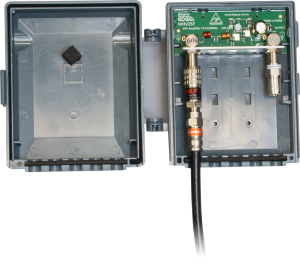1. When do you need a 4G filter?
Whenever you’re working with an AMPLIFIED TV signal, you should consider using a LTE filter before the amplifier. These days, one of the more common reasons for lost TV signal is 4G interference from a phone towers overloading masthead amplifiers.
Kingray FL694LP LTE filter
2. If in doubt, is it better to have filters everywhere or just one?
A single filter is better. Industry conscientious from the likes of Hills and Kingray is that using multiple 4G filters can have a detrimental impact on the signal.
3. Should the TV antenna have a 4G filter?
In most cases try to avoid inbuilt 4G filters in antennas and choose a “well cut” antenna. The inbuilt filters in antennas might be handy when retail splitter amplifiers are used.
Pictured here is the Kingray SA162F splitter amplifier
4. Where should the filter be?
You should rely on the masthead to filter 4G signal. Just about all our Aussie-made Kingrays include around 25dB to 30dB of 4G filtering which should be sufficient. If you have severe interference, stick an extra filter before the input of the masthead, as pictured below: The filter should fit neatly inside the masthead enclosure.
5. What about band pass filters?
When we switched to digital TV, all the TV transmission towers around the country were organised into 5 channels blocks: A, B, C, D, E. Band pass filters will attenuate signal to either side of one (or more) of these blocks. This comes in handy when you’re getting a signal from multiple channel blocks or TV towers.
6. What band pass filter options are available?
There are 2 popular options. The Matchmaster FD0x band pass filter. These have been around for a while and are loved by the trade. They are placed on the pole below the antenna.Just now Aerial Industries (AI) have released their band pass filter solution. These look more like standard attenuators and should be screwed directly to the antenna balun. The AI band pass filters are colour coded according to the channel block.
7. Are band pass filters really necessary?
Not always, but they are a simple fix. To explain, think of Radio Parts in West Melbourne. Here we receive both block A (VHF)* and block D (UHF). Combination antennas and wideband masthead amplifiers were historically used which would receive both signals. A band pass filter might be an easy fix ensure we get a signal from just one tower.The ideal solution involves choosing an antenna cut to VHF or UHF (not both) and a masthead that is either VHF or UHF and not wideband. If problems still persisted, you’d look at a band pass filter. The MHV25F(see below) is a VHF only masthead amplifier.
This article was featured in our November 2016 Newsletter click here to see more: http://www.radioparts.com.au/newsletter



